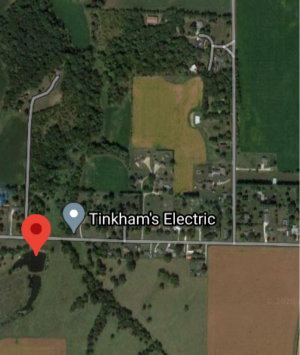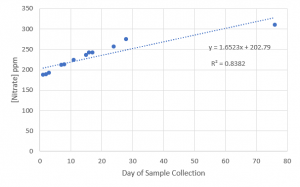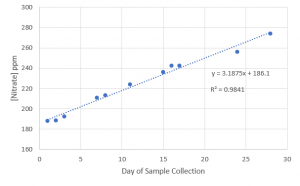Nitrate in the Freshwater Fish tank
Introduction
Nitrates in surface water primarily result from the decay of autotrophs and from chemoheterotrophic life, for nitrates are a byproduct of the waste produced from the consumption of organic molecules as an energy source. Fish are the primary chemoheterotrophs in aquatic ecosystems; therefore, they are accountable for the majority of nitrogen found in water. Ammonia is the main component of fish waste, which is a very toxic compound of nitrogen, but aerobic ammonia oxidizers convert ammonia to nitrite via the intermediate hydroxylamine, which requires aid from ammonia monooxygenase and hydroxylamine dehydrogenase (1). Nitrite is an even more toxic form of nitrogen, but this is further oxidized to nitrate via another type of nitrogen bacteria with the enzyme nitrite oxidoreductase(1). In nature, nitrates are regulated to a certain extent through aquatic plant life, for it is essential in the production of chlorophyll (2). In fish tanks, however, algae is the only natural nitrate regulator, but unlike more complex and nutrient dependent plants, algae is able to grow beyond the capacity of a given ecosystem with ease. Algae cannot convert nitrogen to a gas that can escape the system, so when it dies, nitrogen is released back into the system (2). In closed systems, like that of a fish tank, mechanical work such as changing out volumes of water, being mindful in not overfeeding the fish, and cleaning off the algae and filtration systems, is required in order to ensure nitrate levels are kept at a safe and constant concentration.
This experiment aims to quantify the rise in daily nitrate levels from the few sources of nitrate in a closed off fish tank system by way of using the Thermo Fisher ScientificTM DionexTM AquionTM Ion Chromatography System with the built in Chromeleon 7 Chromatography Data System software. While there are no direct regulations published by the EPA for nitrate and nitrite levels in a fish tank, this experiment utilized the EPA's recommendations for surface water systems. The EPA has set different guidelines for surface water that is just a reservoir for aquatic life and water that is used for human consumption. The maximum contaminant level for nitrates and nitrites in drinking water in the U.S.A. are 10.0 ppm and 1.0 ppm respectively (3). For water systems not being used as drinking water or connected to public water systems, such as isolated ponds, the EPA recommends that nitrate levels do not exceed 60 ppm and that nitrite levels should be kept as close to 0.0 ppm as possible (3).
With a focus on nitrates and nitrites, chloride and sulfate concentrations were also investigated in this experiment. To serve as a comparative analysis, freshwater samples from a connected creek and pond system and ground water samples from a closed off underground spring were also run on the Ion Chromatographer. The EPA defined the maximum Contaminant level for chloride in drinking water as 250 ppm and interprets chlorides as chronically toxic to freshwater aquatic life at 230 ppm and acutely toxic at 860 ppm (4).
Materials and Methods
Instrumentation
Data was collected on the Thermo Fisher ScientificTM DionexTM AquionTM Ion Chromatography System with the built in Chromeleon 7 Chromatography Data System software. Analysis of the desired anions was carried out using the (name of column) column with a 4.5 mM sodium carbonate and 1.4 mM sodium bicarbonate mobile phase and the flow rate kept constant at 1.2 mL/min. Currently the software is programmed to detect eight common anions (chloride, fluoride, acetate, sulfate, nitrate, nitrite, phosphate, bromide), but for this study, standards were only made to analyze nitrate, nitrite, chloride, and sulfate.
Calibration Standards
The anion calibration standards were prepared by dissolving 0.06620 g KNO3, 0.06100 g Na2NO3, 0.05970 g Na2SO4, and 0.05970 g NaCl into four separate 100 mL volumetric flasks to yield 400 ppm stock solutions for all four anions. With appropriate dilutions, these stock solutions were combined to give rise to 10, 20, 40, 80, and 100 ppm stock solutions of calibration standards.
Fish Tank Set-Up
The closed system for which data was collected consisted of a 29 gallon freshwater fish tank with convict cichlids. An Aquatop Canister Filter was connected to the fish tank via a hose and cleaned before sample collection took place. A water top off system was put to use in which a float water level sensor was calibrated at the 29 gallon mark to ensure the water level remained constant in order to eliminate nitrate increments due to evaporation. A feeding mechanism with the Zacro Automated Fish Feeder was devised so that 1.0 gram of TetraCichlid Floating Cichlid Pellets would be delivered twice a day. This was accomplished by setting the automated fish feeder to release 1 meal portion at 8:30 and 16:30.
Fish Tank Samples
In order to see how mainly nitrate and nitrite levels change from day to day in a closed system, 11 water samples were collected throughout the span of 28 days at roughly the same time each day (17:00 - 30 minutes after the second feeding cycle) and stored at 4°C before analysis. One sample was collected 76 days after the first sample was collected in order to gauge whether nitrate levels continue to rise at the same rate or if they level off eventually. After filtering these samples with 0.45 um hydrophilic filter units and a one in five dilution, these samples were run on the Thermo Fisher ScientificTM DionexTM AquionTM Ion Chromatography System with the built in Chromeleon 7 Chromatography Data System software, with two sets of nitrate, nitrite, and chloride calibration standards of 10, 40, and 100 ppm.
Fish Food Analysis
In order to see how much nitrate entered the system directly from the food source being supplied to the tank, a portion size of 1 gram of the TetraCichlid Floating Cichlid Pellets was diluted in 1 L of milipore water, centrifuged for 5 minutes at 300 RPM and analyzed on the ion chromatographer with the same standards as the evaporative fish tank samples were.
Pond and Creek Water Samples
Freshwater samples from a creek and a pond were collected from the locations displayed in figure 1. After a one in five dilution, they were analyzed on the same Ion Chromatography System as the fish tank samples, with nitrate, nitrite, chloride, and sulfate standards of 10, 40, and 100 ppm.
Ground Water Samples
A water sample from a private well that draws directly from a natural underground spring was collected along with a sample from the well source ran through a water softener. Ground water samples were not diluted prior to analysis.
Results
Fish Tank System
The rate of daily nitrate concentration was determined to be 2.5912 ppm/day. This is due to metabolic activity by way of the fish, algae interference, and mainly evaporation (figure 3). The portion size of fish pellets dissolved in 1 Liter was determined to have a nitrate concentration of 2.8564 ppm. Considering that the fish were fed twice a day by this same amount and that the tank is filled to 29 gallons when in the system this becomes a nitrate concentration of 0.0520 ppm. It was determined that nitrate increments due to the direct food source could be excluded since the amount of nitrate in the food is negligible compared to other causes.
Ground and Surface Water Analysis
Table 1 displays the results of the varying anion concentrations in the creek, pond, and ground water samples.
| Anion | Creek Water Sample | Pond Water Sample | Well Water Sample | Well Water Sample w/Softener |
|---|---|---|---|---|
| Chloride | 108.055 ppm | 33.8505 ppm | 18.467 ppm | Example |
| Nitrite | 0 ppm | 0 ppm | 0 ppm | Example |
| Nitrate | 13.079 ppm | 10.875 ppm | 11.9325 ppm | Example |
| Sulfate | 39.737 ppm | 16.8185 ppm | 13.1475 ppm | Example |
Discussion
Figure 3 demonstrates that nitrate concentrations do end up leveling off when they become high, for a linear relationship is only observed for days 1 - 28 and not for day 76. This may be due to increased algae growth due to nutrient abundance and hence increased algal nitrate uptake. Keeping this in mind, the formula can only serve a good model for when the daily rise in nitrate demonstrates a linear relationship (day 1 - 28); therefore, calculated water exchanges via the equation below should take place within this key period.
Even though the rise in daily nitrate concentrations was quantified over a 28 day span in this experiment, this rate does not serve as an absolute representation of daily nitrate increments for all year round. Sample collection took place in mid winter; therefore, during periods of increased metabolic activity, such as nesting and breeding seasons, the rate of daily rises in nitrate concentration is expected to be higher. Another factor to keep in mind is the population of the fish tank.
Though natural regulation proves to be useful in open surface water systems, there are a lot more variables in how nitrates and nitrites can enter the system, therefore, . Although mainly byproducts from aquatic life, nitrate and nitrite levels in surface and ground water can also result from agricultural runoff (fertilizers), or improper disposal of human and animal waste (). Considering the pond and creek are interconnected to each other and have equal exposure to potential agricultural runoff, it makes sense that these two systems have very similar nitrate concentrations as seen by table 1. While the creek and water samples collected came from a reservoir for aquatic life, it is likely the nitrate levels are also a result from the heavy agricultural activity surrounding the open system. Even so, the nitrate and nitrite levels are well below the EPA's guidelines for surface water not serving the purpose as drinking water. Road-salt runoff, which primarily consists of NaCl, can pose a major threat to surface water quality and aquatic life. Even in warm weather months, when roads are not being salted, chloride levels from winter salt applications persisted in a study carried out in Milwaukee Massachusetts (5). Road salt is the primary reason why the creek water sample has a higher chloride concentration than the pond water sample (figure 1).
References
1. Harms, G.; Layton, A. C.; Dionsi, H. M.; Gregory, I. R.; Garrett, V. M.; Hawkins, S. A.; Robinson, K. G.; Slayer, G. S. Real-Time PCR Quantification of Nitrifying Bacteria in a Municipal Wastewater Treatment Plant. Am. Chem. Soc. 2002, 37, 343-351.
2. Ullrich, W. R.; Lazarova, J.; Ullrich, C. I.; Witt, F. G.; Aparcio, P. J. Nitrate Uptake and Extracellular Alkalinization by the Green Algae Hydrodictyon reticulatum in Blue and Red Light. Journal of Experimental Botany. 1998, 49, 1157-1162.
3. U.S. Environmental Protection Agency. https://www.epa.gov/
4. U.S. Environmental Protection Agency. Ambient Water Quality Criteria for Chloride. Office of Water Regulations and Standards Criteria and Standards Division. 1988.
5. Corsi, S. R.; Graczyk, D. J.; Geis, S. W.; Booth, N. L.; Richards, K. D. A Fresh Look at Road Salt: Aquatic Toxicity and Water-Quality Impacts on Local, Regional, and National Scales. Environmental Science & Technology. 2010, 44, 7376-7382.
Page History
This page was created by Sara L Simonson in the fall of 2020


